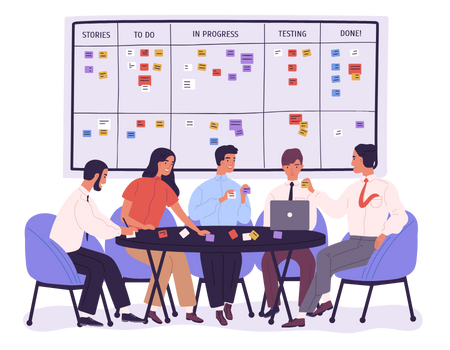The HR metrics that matter most in 2023
Most companies have long taken a data-driven approach to sales, marketing, and customer satisfaction — but more and more companies now realize the benefits of tracking HR analytics (also called people analytics). In fact, according to a study by Deloitte, 69{3df20c542cc6b6b63f1c547f8fb389a9f235bb0504150b9df2ff264aa9a6c16c} of large organizations have formed a people analytics team with an associated database.
The key takeaway from the study is that people analytics are here with a vengeance, which is why HR teams & leaders should get on board sooner rather than later.
With that in mind, how do you know which KPIs and HR metrics to track at your organization?
After all, there are tons of HR metrics that you can track by analyzing employee data, including turnover rate, absenteeism, employee turnover, retention rate, and many others.
While every HR metric has merit, some key metrics will matter more to your C-suite and overall business growth. Analyzing and improving on these metrics will lead to higher levels of employee satisfaction, a healthier company culture, boosted productivity, and more revenue.

To help you get started with data-driven decision-making in your human resources department, we’ve compiled the HR metrics that matter most in terms of recruitment, equity, retention, and productivity.
Read on to discover how to get the most out of the HR data at your organization.
Why are HR metrics important?
HR metrics are specific measurements that determine the effectiveness of your HR initiatives — such as employee engagement, turnover rate, onboarding, employee retention, and more. Without accurate human resources metrics to measure, you’ll have no way of knowing whether your HR department is underperforming.
For instance, if you don’t track crucial metrics related to recruitment, your hiring process could be completely inefficient, and you’d have no idea. Only by analyzing recruitment data can you realize that you have a problem that’s costing your organization money, which is why paying attention to HR metrics is so crucial.
Speaking of recruitment, research shows that 74{3df20c542cc6b6b63f1c547f8fb389a9f235bb0504150b9df2ff264aa9a6c16c} of companies are underperforming in their recruiting efforts, which reinforces the need for stringent recruitment analytics and KPIs. It’s not just the recruitment process where you need to pay attention to key HR metrics, either. Every area of HR has metrics that matter, including diversity, equity, retention, and employee experience.
Besides helping you boost the productivity & efficiency of your initiatives, analyzing HR metrics will uncover unique insights hidden in mountains of data. For example, analyzing a specific employee’s data can uncover hidden talents and skills you didn’t know they had, making you realize they’re perfect for a different role at your organization.
Also, HR leaders regularly collaborate with other departments on decision-making and business initiatives, especially CFOs. As such, they need up-to-date HR metrics to share with finance departments to make informed decisions about benefits & rewards, compensation, and human capital.
It’s common for organizations to accrue so much HR data that it becomes practically impossible for anyone to sift through it all manually, which has led to the prevalence of HR software systems like HRIS and HCMs.
The benefits of data-driven HR analytics
 If you want your organization to stay competitive today, paying attention to the HR metrics that matter most is an absolute must.
If you want your organization to stay competitive today, paying attention to the HR metrics that matter most is an absolute must.
Tracking HR data will do a lot more than keep you competitive, though, as you’ll enjoy many organization-wide benefits from it. Here’s a look at the top perks you’ll enjoy from evaluating your employee data.
Identify opportunities & trends across all departments
The great thing about HR data analysis is that the benefits don’t only affect the HR department but the organization as a whole.
How’s that?
For example, by analyzing HR metrics to design better reward programs for salespeople, you can increase the overall revenue of the sales department. Finance-wise, improving employee retention and turnover rates will boost productivity and save the finance department lots of money.
Labor market trends also differ from industry to industry, and concise people analytics are the best way to understand how they affect your organization. Understanding the labor trends in your industry will help you discover & retain new hires with top-tier skills, as well as perfect your interview process.
Make your organization more agile
In the current era, businesses must be highly agile in adapting to new changes in the workplace, especially technology. The pandemic was a prime example of this, as companies around the globe had to scramble to adapt to remote work & processes.
The advent of AI programs is another quickly-emerging trend that’s taking over the business world at a rapid pace. Companies from all industries are now adopting AI systems to handle everything from customer service support to generating content and beyond.
The good news?
HR metrics & employee data will drastically improve your organization’s agility and innovation capability. Crucial metrics like quality of hire, employee productivity, and employee performance can clue you in on how effective you’re being at recruiting top talent capable of innovating & adapting to current technological trends.
The most valuable companies in the world understand the value of agility and innovation (think Apple, Amazon, Google, etc.), which is why they’ve become so successful, so you should follow suit.
Uncover why employees leave
A high employee turnover rate will raise serious concerns for any company, often leaving HR professionals in confusion.
That’s because, without detailed employee data, it’s next to impossible to discover why employees choose to leave, as the true reasons often remain unspoken. Yet, by examining HR metrics like eNPS (employer net promoter score), employee turnover, and job satisfaction — you can uncover which roles, teams, & departments are causing employees to leave.
By focusing your efforts on these areas, you can remedy your high turnover and start retaining your top talent for far longer.
Not only that, but specific HR software programs can predict if an employee plans on looking for a new job, even before they make themselves available. That will help you discover which positions you need to prepare to hire for in advance.
The 10 HR metrics that matter the most
The effectiveness of your HR department directly impacts the success of your organization, as recruiting, onboarding, turnover, and job satisfaction are factors that affect all departments.
Organizations can only hope to succeed if they attract and retain top talent, which is why monitoring recruitment metrics and key performance indicators are necessary.
Some metrics are more important than others, especially to your C-suite and department heads.
To make data analysis easier for you, I’ve compiled the 10 most important HR metrics to pay attention to at your organization.
#1: Cost-Per-Hire
Do you know approximately how much it costs your organization to hire a new employee?
If not, there are plenty of software tools that will provide you with your cost-per-hire metric, which refers to the average cost of acquiring new employees. Calculating it involves analyzing your internal and external expenses involved with recruitment, including salaries, onboarding costs, training programs, etc.
Most importantly, this metric will quickly let you know if you’re spending too much money on recruitment, and you’ll be able to pinpoint the areas where you’re overspending, such as spending too much time conducting interviews.
Once you acquire enough data to track how much it costs to onboard a set number of new hires over a specific period of time, you’ll be able to accurately calculate your cost-per-hire. Regardless of your organization’s industry, cost-per-hire is always a crucial metric that will impact your bottom line, which is why it tops the list.
What’s a desirable cost-per-hire?
You should shoot for a cost-per-hire between $2,000 to $5,000 — to give you a realistic benchmark. If it costs your organization more than $5,000 to recruit new hires, you’ve got some work to do.
#2: Time-to-Fill & Time-to-Hire
These two metrics share the #2 spot because they go hand-in-hand. If you want to snatch up top-tier candidates, you need to have both metrics honed to as small a window as possible.
Why is that?
It’s because the most qualified candidates are off the market within 10 days, while it takes most organizations an average of 36 days to fill an open role. So if you want to acquire top talent, your recruitment process needs to be extremely quick & proficient.
While the two terms often get used interchangeably, there is a noticeable difference between them.
Time-to-fill refers to how long it takes the entire recruitment process, from the time you post the job to the time the position is filled.
Time-to-hire is similar but only refers to how long it takes from the time a candidate interviews until they get the job.
Accordingly, time-to-fill measures the efficiency of your organizational hiring process, while time-to-hire specifically measures the efficiency of your recruitment process.
It’s worth measuring both because you’ll be able to pinpoint where any potential issues may be in your hiring process. If you only measure time-to-hire, you may miss out on inefficiencies that occur during the job posting process, which takes place before you start interviewing individual candidates.
#3: Employee Growth Rate
 For an organization to stay healthy and thrive, it needs to achieve consistent growth. The employee growth rate metric measures how much your company has grown over a set period of time. You can use it to determine if you’re enjoying growth or are staying stagnant, which is something your stakeholders and executives will definitely want to know.
For an organization to stay healthy and thrive, it needs to achieve consistent growth. The employee growth rate metric measures how much your company has grown over a set period of time. You can use it to determine if you’re enjoying growth or are staying stagnant, which is something your stakeholders and executives will definitely want to know.
Ideally, you’ll want your employee growth rate to be around 2 to 4{3df20c542cc6b6b63f1c547f8fb389a9f235bb0504150b9df2ff264aa9a6c16c}. A higher number means your business is growing, and a lower number means that more employees are leaving the company than those that are joining it.
While growth is always good, companies that grow at a rapid pace have more complex needs than ones that aren’t growing as fast. That’s why it’s wise to keep your growth rate within the sweet spot of the 2 – 4{3df20c542cc6b6b63f1c547f8fb389a9f235bb0504150b9df2ff264aa9a6c16c} range; otherwise, you may begin to grow beyond your means to scale along with it.
#4: Pay Equity
Also called pay transparency, pay equity is a growing trend in HR departments across the United States. The idea is for companies to be entirely transparent about what they pay employees so as not to hide any pay discrepancies.
As a result, companies with pay equity pay all employees equally, which shows they don’t discriminate toward anyone’s age, gender identity, race, or other reasons. It’s essential for modern organizations to be diverse & equitable, which is why pay equity makes our list.
To see if you have any pay equity issues, dive into your payroll data to discover how you’ve been paying your staff. That will also help you determine what you should pay your future hires to keep things fair.
#5: eNPS
As stated previously, eNPS stands for employee net promoter score.
What does that mean?
The metric refers to how likely an employee is to recommend your organization to someone else. If an employee wants to recruit their friends and family to work at your company, it’s a clear sign that they’re satisfied with their job.
Not only that, but a high eNPS score will help out your recruitment efforts in a big way, as you won’t have to spend as much time & money finding qualified candidates. As a result, improving your eNPS score can bolster other crucial HR metrics, such as time-to-fill, time-to-hire, and cost-per-hire.
It also happens to be the easiest HR metric to measure. All you have to do is send a survey to your employees that says,” On a scale of 1 – 10, how likely are you to recommend this company to others as a place to work?”
Once you get the results, you can segment employees into brand evangelists (scores 9-10), passives (7-8), and detractors (0 – 6).
To formally calculate eNPS, subtract your number of evangelists from your number of detractors, and divide that number by the total number of respondents. Scores between 40 and 50 are incredible, 30 and 20 are okay, and 0 to 10 aren’t good.
Your eNPS score can provide insights into employee engagement, turnover rate, and employee performance.
#6: Absenteeism Rates
Next, you’ll definitely want to pay attention to your absenteeism rates, as they undoubtedly affect your bottom line.
Absenteeism refers to the total number of absences from your employees. Whenever absences become habitual or excessive, they can put a serious damper on your productivity. As a result, high absenteeism rates could be causing your organization to hemorrhage money, which is why it’s wise to keep an eye on them.
To calculate your absenteeism rate, divide the number of unexcused absences by your total number of workdays and then multiply the results by 100.
Ideally, your absenteeism rate should be as close to zero as you can get it, so the lower the number, the better.
#7: Presenteeism Rates
Equally as important as measuring absenteeism is presenteeism, which is similar but slightly different.
How is that?
In particular, presenteeism refers to employees that show up for work but are highly unproductive. Reasons for this vary, including dealing with pain or illness, a lack of engagement, and personal issues at home. Employees engage in presenteeism whenever they’re aimlessly sitting at their desks ‘pretending’ to work.
It’s a serious issue that, like absenteeism, can cost companies thousands in lost revenue if it’s not kept in check. Presenteeism is a bit tricky to calculate, but the most basic way is to send your employees a simple survey that asks,” What percentage of time during the week are you at work yet unproductive?”
From there, you can take that average and pop it into the following formula:
40 hour work week x {3df20c542cc6b6b63f1c547f8fb389a9f235bb0504150b9df2ff264aa9a6c16c} of time lost x 52 weeks = the number of hours lost per year
After that, multiply the number of hours lost by your average employee’s salary, and you’ll wind up with the grand total that presenteeism is costing your organization.
#8: Internal Promotion Rate
A high internal promotion rate will improve job satisfaction and employee turnover rates. After all, one of the top reasons an employee leaves a company is to pursue more attractive opportunities elsewhere. Well, if you provide plenty of opportunities for advancement at your company, you’ll stand a greater chance of retaining your top talent.
Things like continuing education programs, more robust training, and regular coaching sessions with managers can improve your internal promotion rate.
#9: Employee Satisfaction
A workforce that’s engaged and satisfied with their work will perform better than those who are not, and they’re more likely to stay with your organization for longer.
That’s why improving employee satisfaction should be a goal of any company.
To measure this crucial HR metric, you can use an employee survey tool to check in with new hires, measure employee engagement, and perform exit analysis. It’s also wise to elicit an environment where employees feel comfortable providing their managers with honest, open feedback.
#10: DEI Initiatives
Last but not least, diversity, equity, and inclusion (DEI) metrics are crucial for any organization in today’s age.
To track your company’s progress in this regard, you can send out a survey quizzing employees on what they know about your DEI initiatives. If the results are less than satisfactory, it’s a sign that you need to provide DEI education & training programs for your teams.
You should also collect metrics for inclusion and belonging, although those are a bit more complex to calculate. Yet, they’re essential because employees who don’t feel included will leave your company. To gauge the inclusiveness at your company, closely examine the turnover demographics for each department and team. Also, pay attention whenever people of color or women get promoted to higher roles versus their counterparts.
Final thoughts: HR metrics that matter
Knowing which HR metrics to track is essential for any organization that wants to compete in the modern era. Getting a grasp on your turnover rate, engagement levels, and the effectiveness of your recruitment tactics will let you know how efficient your organization is as a whole.
Analyzing the HR metrics that matter most will also help you identify inefficiencies and areas for improvement, which will help you boost productivity, revenue, and job satisfaction among employees.
Did I miss any HR metrics that you track at your organization? Let me know in the comments.




:quality(70)/cloudfront-eu-central-1.images.arcpublishing.com/irishtimes/SL4ZJEXTC5DIXNN4OZFLJTU4UE.jpg)


